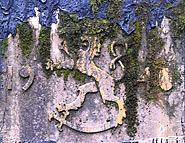Harparskog Defense Line
March 12, 1941 Winter War ended. Finland was fain to yield a big part of it's territory in south Karelia and Hanko peninsula also. It was rented by USSR for naval base deployment for 30 years. It is not a bad place for naval base because there is only 80 kilometers distance to Estonian Paldiski town (Soviet territory and naval base too in that times). Distance between islands Russarö and Ösmussar less than 60 kilometers and could be easy covered by 12 inch guns. Hereby entrance to Gulf of Finland could be closed easily. One more point: distance from Hanko to capital of Finland near to 100 kilometers. It is one and half hours riding for Soviet tank BT-7...
In the middle March,1940 the order about sector Hanko defence was signed. In June, 1940 the troops of the area (so called "Hanko Group) consists of 17th infantry division, 4th Coastal Brigade and Frontier Guards units. Colonel Aarne Snellman was in charge of the Group at first, than Colonel Lieutenant Kesämaa and August, 1941 the commander of Hanko Group become Colonel Koskimies.
Planning of the fortifications begun March 29, 1940. It was decided to construct defence line close to the border of the rented area of Hanko Cape. The H-Line (Harparskog Line) should cover the Hanko peninsula neck and coastal line from Sommarö to Bredvick. The central sector (Harparskog-Skogby) was the most important part.
Planning was finished midsummer 1940 end construction begun. Field Marshal Mannerheim inspected construction sites winter 1940/41.
Latterly May, 1941 there were erected 46 concrete machine gun, machine gun/artillery and accommodation/command point bunkers and other 141 bunkers were under construction. Were ready near to one hundred concrete mg-pits, 29 artillery positions for antitank guns, 46 dugouts, near to 57 kilometers barbed wire obstacles and antitank obstacles - so called "Dragoon teethes" or rows of huge granite rocks. There were 9 kilometers such antitank obstacles in the Central Sector only. H-Line was covered by 70 pieces of artillery on prepared positions with 17 Control Fire Posts. I estimate the full depth of the Line at it's Central Sector 2-3 kilometers (include field position near to border of the rented area).
Warfare on the Hanko begun June 29, 1941. Fights in the Central Sector took place along the borderline of the rented area (near Lappohja), so Harparskog Line installations were in the rear and was not involved to the battles directly. But many Finns believes that it's support and presence keeps the Soviet troops off dash to Helsinki and free part of Finnish force for front in Karelia.
Most bloody battles of Hanko area took place on the small islands near to the border of rented area. One of example was the battle on the Elmhölm island August 16. Local landing actions were extremely bloody because defenders of islands had no way to retreat and landing troopers on it's slow wooden boats had no place to hide under the mortal fire from the islands.
December 4, 1941 Soviet naval base was evacuated and Hanko siege ended. Sweden volunteers, which fought on the positions of the Central Sector, crossed front line and entered to the empty city first.
After WWII Soviet Union gave Hanko naval base up and demanded Porkkala Cape territory instead of it. It was more effective because there was possibility of artillery shelling to Finnish Parliament building in Helsinki directly and hereby possibility to affect to politic life in Finland. Harparskog Line significance decreased very much but it was not abandoned at all.
The H-line was in military use till the middle 1960-th at least. According to Pekka Silvast it was rearmed and reconstructed in that period of time because of "Cold War". Later the installations of the Line were conserved and guarded till the end of 1980th by Finnish Defence Forces. Early in 1990th the Line was abandoned but brass used it for conscripts training sometimes (I've found number used submachine gun's cartridges in several places of the Line) and used some installations as warehouses.
At present most of the bunkers are abandoned. Some of them are locked, but some of locks are forced. There are symptoms of restoration works in few bunker and big one in Harparskog village transformed to the museum. 2-3 bunkers are in process of transformation to the museums objects too.
PS: There is a strict law in Finland named Muinaismuistolaki (Law About Historical Monuments). You could be panished for change, demage and digging such historical places. Look out!
Impressions
Impressions are very good. This is the powerfull defence line in excellent condition. Most of it's installations are accessible for free. Damp course of the bunkers in the good condition as rule. There are some equipment inside of installations such as stoves, air and water tubes, pumps, cans etc. One of the characteristic of the Line is a big density of installations - there are near to 30 on the relatively small area of 4x4 kilometers dimension.
The fascinating and near untuched forest with planty mishrooms, bilberry and cowberry covers the area. Good roads provides easy access to the installations. All is beauteful... but do not forget to buy a tickets in the trains...
Land forts and fortress:
Bip Castle Gatchina Ivangorod Izborsk Kexholm Kirillov Monastery Koporye Novgorod Pechorskiy Monastery Peter&Paul Fortress Porkhov Pskov Schlisselburg Staraya Ladoga Tikhvin Vyborg Hameenlinna Hamina Kastelholm Kymenlinna Lappaenranta Raseborg Castle Savonlinna Tavetti Turku Visby Fredrikstadt Fredriksten Hegra Fort Hoytorp Fort Arensburg Narva Tallinn Antipatris Caesarea Jerusalem Latrun Fort Masada
Sea forts and fortresses:
Alexander Fort Ino Fort Krasnaya Gorka Fort Kronstadt: Kotlin isl. Kronstadt: North Forts Kronstadt: South Forts Trongsund Hanko Svartholm Sveaborg Marstrand Siaro Fort Vaxholm Oscarsborg
Artillery batteries and individual guns:
Coastal Artillery Hemso Fort
Fortified areas and defensive lines:
Karelian Fortified Area (KaUR) KrUR Leningrad Mannerheim Line Nevsky Bridgehead VT Line Harparskog Line Salpa Line Gothland
Russian
S e a r c h All news














